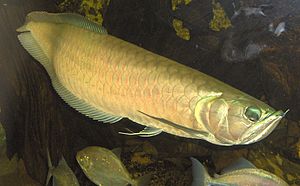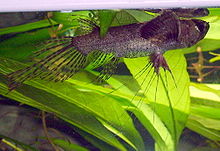Ossicularly
| Ossicularly | ||||||||||||
|---|---|---|---|---|---|---|---|---|---|---|---|---|

Arowana ( Osteoglossum bicirrhosum ) |
||||||||||||
| Systematics | ||||||||||||
|
||||||||||||
| Scientific name | ||||||||||||
| Osteoglossiformes | ||||||||||||
| Regan , 1909 |
The osteoglossiformes (osteoglossiformes ( Gr .: “Osteon” = bone + “glossa” = tongue; Latin , “forma” = shape)) are an order of primitive real bony fish (Teleostei), which are disjoint on the southern continents (South America, Africa, South Asia , Australia) is common. These are residual occurrences in a larger distribution area in the past that also included Europe, North America, Central and East Asia. Almost all of the bone -winged fish are pure freshwater fish , only some Old World knife fish also go into light brackish water . The order includes six families, two of which contain only one species, another only four, two more nine and ten and the most species-rich, the Nile pike with over 210 species makes up almost 90% of the diversity of the order.
features
The bone-wolf-like are very different in body shape and way of life. They generally have an elongated, laterally flattened body and reach lengths of five centimeters to over a meter. The largest species, the Arapaima ( Arapaima gigas ), is said to have reached a maximum length of 4.5 meters according to older reports, which can no longer be verified, and would therefore be the longest pure freshwater fish . Lengths of two meters have been confirmed.
The tongue, which has well developed teeth, gives the order its name, and the parasphenoid is also dentate. Both form a scissor bite. The teeth of the tongue are absent in the great nil pike ( Gymnarchus niloticus ) and the African bone pike ( Heterotis niloticus ). Since the parasphenoid teeth also occur in other primitive Teleostei ( plesiomorphism ), they cannot be regarded as autapomorphism of the bone-wolf-like. In all species, however, there are further teeth on the ectopterygoid and mesopterygoid (bones of the wing bone ). The premaxillary is small and firmly attached to the skull. The supramaxillary, a bone of the upper jaw, is absent. The nasal capsule is rigid and there is no antorbital-supraorbital system to pump water over the olfactory mucosa . Epipleuralia (bones) are absent. The butterfly fish ( Pantodon buchholzi ) has one appendix , the other bone-wing fish have two. There are also one or two pyloric tubes . The caudal fin is supported by 16 (only in the Arapaima) or less branched fin rays. The caudal fin skeleton has two or one uroneuralia , urodermalia (cover bones made of sunken, fused scales) are missing.
nutrition



The diet of the different types of bones is very different. The big bonesfish, knife fish and large nil pike in particular are predatory fish that mainly feed on other fish. Osteoglossum species also prey on large insects, frogs and small bats . The butterfly fish eats insects and spiders that have fallen on the surface of the water (approach food), Nile pike and elephant fish are mainly benthic eaters and seek their food on the bottom of the water. The African bonesweed is a filter feeder that only lives on fine plankton and detritus .
External system
The bone-lick-like are united with their sister group , the North American moon eyes (Hiodontiformes) to the taxon of the bone-lick-like (Osteoglossomorpha). These are considered to be the most original real bony fish (Teleostei) still alive today .
Internal system
The order is divided into two subordinate orders and six families. Two families are still combined into one superfamily.
- Family butterfly fish (Pantodontidae)
- Subordination osteoglossoidei
- Family bonytongues (Osteoglossidae)
- Family Arapaimidae
- Suborder knifefish-like (Notopteroidei)
- Old World Knifefish Family (Notopteridae)
- Superfamily Mormyroidea
- Family Nilhechte and Elephantfish (Mormyridae)
- Großnilhecht family (Gymnarchidae)
Phylogeny
The following cladogram shows the relationship between the Osteoglossiformes and the Lycoptera and the Hiodontiformes as outer groups. The position of the butterfly fish is controversial.
| Osteoglossomorpha |
|
||||||||||||||||||||||||||||||||||||||||||||||||
|
|

Fossil record
With Xixiaichthys from China, the fossil record of the bone- wolf-like goes back to the early Cretaceous. Some fossil taxa are grouped together in the Saurocephalidae family , whose fossil records range from the Hauterivian (Lower Cretaceous) to the Bartonian (Eocene). Palaeonopterus from the Chalk of Morocco is close to the Mormyridae and / or the Notopteridae and Phareodus from the Eocene , North American Green River Formation is an early representative of the Osteoglossidae .
use
Many bonesfish are caught as food fish in their home regions. Smaller species, especially the butterfly fish and elephant fish, are exported for aquarium use. Large bones, but also knife fish and Nile pike can often be seen in public show aquariums . They can live there for ten to well over twenty years.
literature
- Joseph S. Nelson : Fishes of the World . John Wiley & Sons, 2006, ISBN 0-471-25031-7 .
- EO Wiley & G. David Johnson: A teleost classification based on monophyletic groups. in Joseph S. Nelson, Hans-Peter Schultze & Mark VH Wilson: Origin and Phylogenetic Interrelationships of Teleosts. 2010, Verlag Dr. Friedrich Pfeil, Munich, ISBN 978-3-89937-107-9 .
Individual evidence
- ↑ Stomatorhinus fuliginosus on Fishbase.org (English)
- ↑ Sebastien Lavoue, John P. Sullivan: Simultaneous analysis of five molecular markers provides a well-supported phylogenetic hypothesis for the living bony-tongue fishes (Osteoglossomorpha: Teleostei). Molecular Phylogenetics and Evolution 33 (2004), page 171-185, PDF
- ↑ Sébastien Lavoué, Masaki Miya, Matthew E. Arnegard, Peter B. McIntyre, Victor Mamonekene & Mutsumi Nishida: Remarkable morphological stasis in an extant vertebrate despite tens of millions of years of divergence. Proc. R. Soc., Doi: 10.1098 / rspb.2010.1639
- ^ MVH Wilson, AM Murray: Osteoglossomorpha: phylogeny, biogeography, and fossil record and the significance of key African and Chinese fossil taxa . In: Geological Society, London, Special Publications . tape 295 , no. 1 , 2008, p. 185-219 , doi : 10.1144 / SP295.12 .
- ^ Z Jiang-Yong: New fossil osteoglossomorph from Ningxia, China. Journal of Vertebrate Paleontology, Sept. 2004, doi : 10.1671 / 0272-4634 (2004) 024 [0515: NFOFNC] 2.0.CO; 2
- ↑ The Paleobiology Database: Family Saurocephalidae
Web links
- Bonebirds on Fishbase.org (English)


